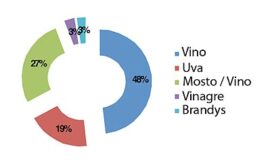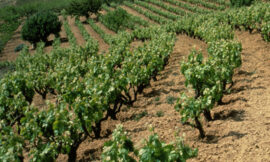The development of a new wine grape cultivar is time consuming requiring about 25 to 30 years – almost the span of an employees working life. Plenty examples can be given such as ‘Phoenix’ crossed in 1964 and protected 1992 or ‘Regent’ which was crossed in 1967 and protected in 1994. It is hardly possible to speed up this time span as for quality evaluation at least 5 to 6 years are necessary for a decision in each breeding step (see Figure 1). However, in future, markers correlating with relevant traits may be used to speed up the selection to some extent.
New cultivars are difficult to introduce into the market. A prerequisite is the registration of a new cultivar for quality wine production. In the beginning the registration was a very complicated procedure which was initiated at a regional level. Therefore the registration of the first cultivars took some time: Phoenix 1994 and Regent 1996. In the meantime registration is an institutional process which occurs with the listing of a new grapevine cultivar in the German variety list. In Germany it is common to sell varietal wines. A tight connection has been established between the cultivar e.g. ‘Riesling’ and its wine Riesling. Different from wines from other countries for German consumers the varietal name of the German wine is very important. This phenomenon creates currently a tremendous burden for marked introduction of new cultivars. As a consequence for future market introduction of new cultivars new concepts need to be developed.
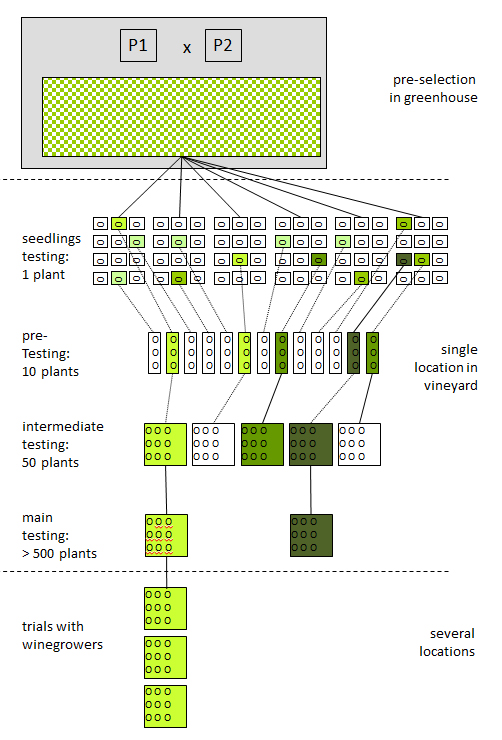
Breeding today
Today’s breeding strategies include already marker assisted selection (MAS) steps permitting for some traits a substantial improvement of the selection process. Good and largely reliable markers are available for a number of resistances against powdery mildew and downy mildew and other pathogens (see Figure 2 and www.vivc.de >> database search >> data on breeding genetics). For many other traits markers are to be developed. Assuming that more traits can be addressed by MAS in a couple of years, the breeding cycle is assumed to be accelerated by up to 10 years. To fulfill this assumption it needs targeted approaches to identify tightly correlating markers. In this respect all quantitative traits remain challenging in particular the quality potential of a genotype. Wine quality is very difficult to evaluate since numerous parameters influence the quality of a wine: the cultivar, the vineyard management, the vintage, the soil, the enology. A more complex but less scientific summary of the term quality is summarized in the terroir concept. From a breeding point of view it is crucial that a given new cultivar shows a high potential for the production of excellent wines in grown in the appropriate conditions. This concept of selection for quality potential can define the breeding goal in a more appropriate way. It is thus to some extend feasible that marker assessed selection for quality potential can be worked out although it will be a long way. Thus, first steps have been done to develop markers being diagnostic for metabolites like muscat flavor compounds1 or for off-flavors found in old hybrids like Catawba (Braun et al. unpublished). Single parameter of quality potential will be stepwise elucidated. An overall description of quality potential will remain a dream for a long time.
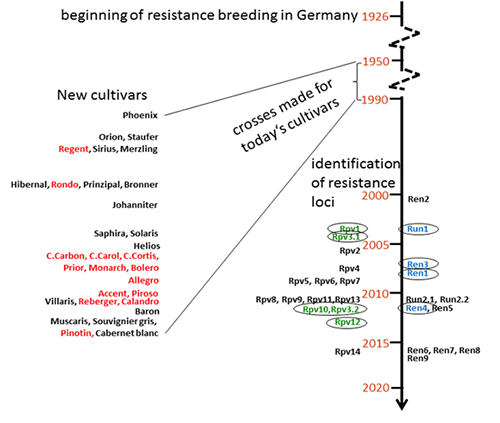
A new cultivar with multiple resistances is expected to be released in a 2018. This genotype denominated ‘Calardis Blanc’ (deduced from a historic name of Geilweilerhof = Gailhardswilre = Calardiswilre) was crossed in 1993 and initiates a new generation of cultivars. These cultivars carry resistances against several grapevine diseases and will accumulate several resistance loci against a particular pest. For ‘Calardis Blanc’ (Figures 3, 3b) the spectrum of resistances is one locus against powdery mildew (Ren3), two loci against downy mildew (Rpv3-1 and Rpv3-2), black rot resistance, and high resilience against Botrytis given by its small berries, loose cluster architecture and tight berry skin. It shows upright growth and a late ripening similar to Riesling in Germany conditions. The wine is fruity and shows decent ‘Muscat a Petits Grains Blanc’ flavors. It passed the selection steps without MAS but later the occurrence of individual loci was tested. Stacking of resistances will be continued and will be the challenge for future cultivar releases that probably will have passed the MAS screening.
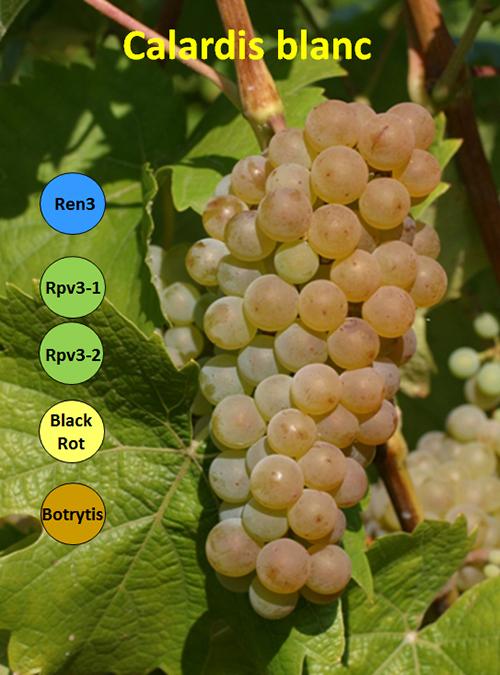
The scheme in Figure 2 is the basic workflow for variety selection. MAS has been integrated since 2005 at the very first step of the workflow for a part of the breeding material. Nowadays breeders can make use of several loci for resistance against powdery mildew being in elite genetic background like Run1, Ren1, Ren3, and Ren4 (resistance Uncinula/Erysiphe necator). For downy mildew the loci in elite genetic background are Rpv1, Rpv3-1, Rpv3-2, Rpv10, and Rpv12.
It is very important to first combine resistance and other relevant traits like quality, yield and others resulting in elite genotypes. As a consequence new resistances need to
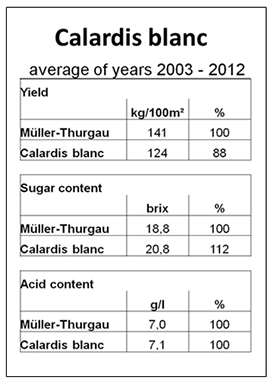
be introgressed into V. vinifera background in a completely separate part of the breeding program by consecutive pseudo back crosses (pBC) of introgression lines. Such introgressions can be assisted during the first back crossing steps by markers (MABC = marker assisted back crosses). MABC up to pBC3 or pBC4 for back bone selection shortens the time to achieve > 97 % of V. vinifera genetic background. Micro vines or pixie vines (flowering from the first year on) or fast growth supporting greenhouse conditions to rapidly achieve flowering and fruit set result in shortening the introgression to a 5 to 10 year period instead of 30 years. The introgression aims at elimination of quality deficiencies conferred from the wild species and identifying lines being essentially free of off-flavors and simultaneously being adapted to the V. vinifera genepool in as many characteristics as possible. Once this has been achieved, lines can be transferred and used in the elite breeding program for variety development. The currently available 4 powdery mildew (PM) resistances and the 5 downy mildew (DM) resistances (encircled loci in Figure 2) in elite genetic backgrounds offer the possibility of creating 40 different combinations if 3 PM and 3 DM (3&3) resistance loci are combined. Such cultivars which are still to be developed permit a further reduction of fungicides in viticulture practice. However, to combat other pathogens which might come up if the plant protection regime is substantially decreased a minimal plant protection needs to be kept. This minimal plant protection will also help to facilitate safeguarding of stacked resistances to achieve highest durability as possible.
These considerations are a logic consequence of today’s management of active plant protection compounds. In chemical plant protection it is strongly recommended to rotate fungicides switching to another group of active compounds in integrated pest management. This concept aims at avoiding resistance formation against one group of active compounds. As chemical compounds can be changed very rapidly while stacked resistances are fixed in a new cultivar once achieved. Thus, it will become necessary to develop adapted concepts of integrated pest management. Otherwise resistances in plants will be overcome by pathogens very soon. Thus, following a precaution principle a minimal chemical plant protection will be required.
References
1. Emanuelli, F.; Sordo, M.; Lorenzi, S.; Battilana, J.; Grando, M. S.: Development of user-friendly functional molecular markers for VvDXS gene conferring muscat flavor in grapevine. Molecular Breeding 2014; 33: 235-41.



